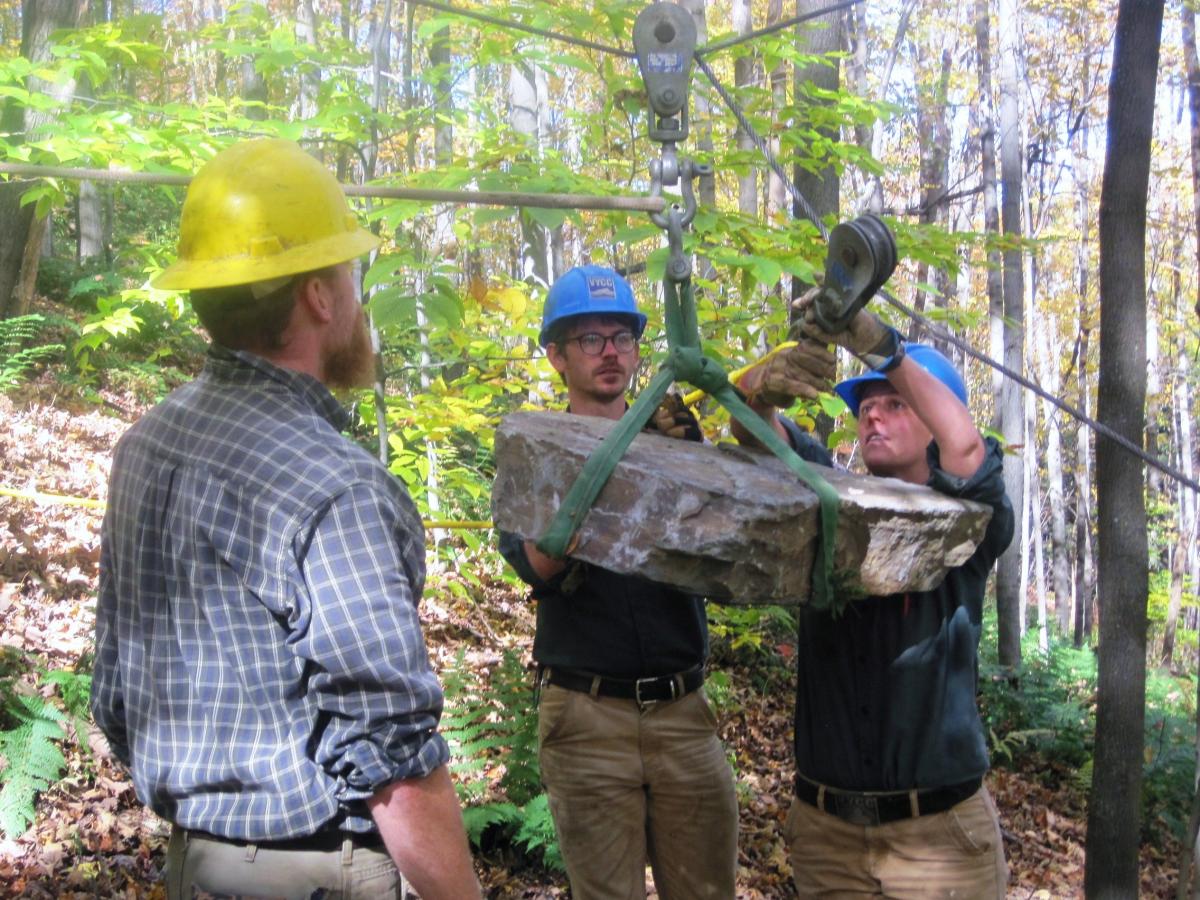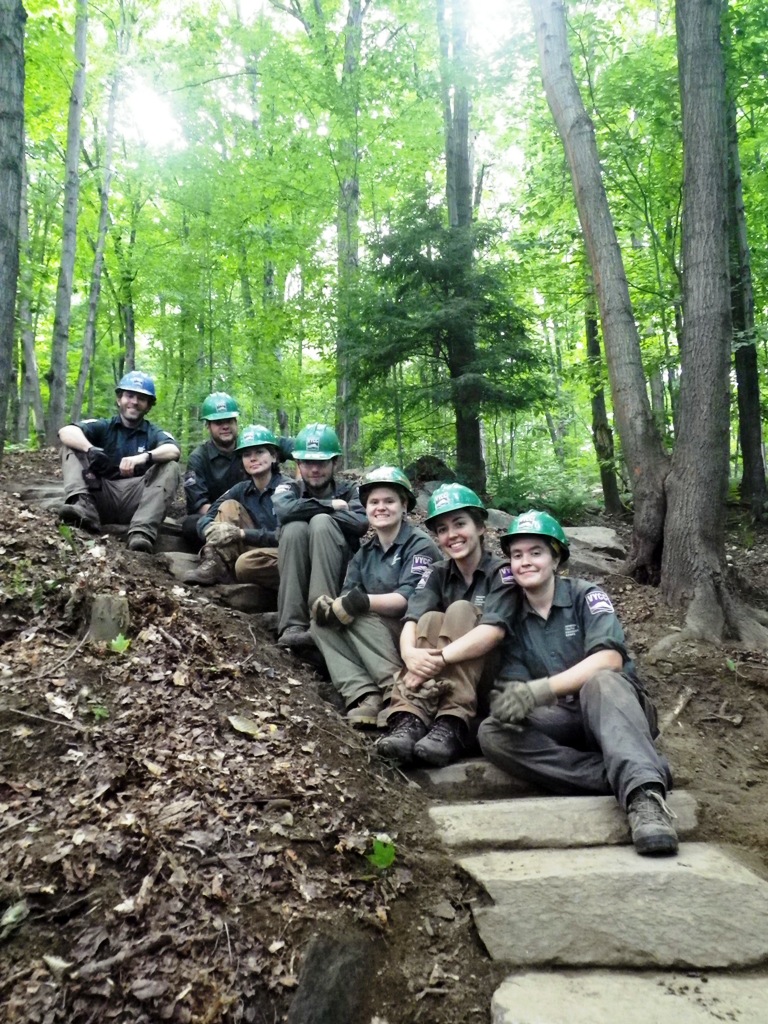

Each year, working with the Vermont Agency of Transportation (VTRANS), Vermont Youth Conservation Corps (VYCC) utilizes federal transportation funds to employ more than 50 diverse youth who complete 24 weeks of work on community-based projects all over the state. These projects include work along rail trails, community transportation linkages, and other highly visible transportation enhancement projects. VTRANS has enthusiastically welcomed the partnership with VYCC as a way to introduce young people to the value of community service, diversity, education, job training, and the many rewarding careers in the transportation industry.
 For the past 3 years, the Corps has been working on an important transportation project in Montpelier, the capital city of Vermont. The challenge was to help provide an improved route for employees working in the large National Life office complex to reach downtown Montpelier. The National Life complex houses Vermont’s third largest private employer, as well as over 1,400 Vermont State employees. Before construction of the National Life Trail, employees walking downtown from the National Life complex, as well as residents of an adjacent neighborhood, had to choose between following a mile long route along the side of a highly trafficked street, or taking a makeshift path straight down a steep hill, known as the “Goat Path.” Neither choice provided safe or accessible passage. The new trail transformed this tiny, eroded, and treacherous path into a beautiful trail and connected the city’s largest office building to the downtown area.
For the past 3 years, the Corps has been working on an important transportation project in Montpelier, the capital city of Vermont. The challenge was to help provide an improved route for employees working in the large National Life office complex to reach downtown Montpelier. The National Life complex houses Vermont’s third largest private employer, as well as over 1,400 Vermont State employees. Before construction of the National Life Trail, employees walking downtown from the National Life complex, as well as residents of an adjacent neighborhood, had to choose between following a mile long route along the side of a highly trafficked street, or taking a makeshift path straight down a steep hill, known as the “Goat Path.” Neither choice provided safe or accessible passage. The new trail transformed this tiny, eroded, and treacherous path into a beautiful trail and connected the city’s largest office building to the downtown area.
Given the high level of human activity within the area, as well as the very steep nature of the trail, the Corps and its crews were presented with new challenges in regard to safety, as well as the logistics of transporting large boulders and materials to build stone staircases. But ultimately, the 3 years of complex project work boosted the technical skills of VYCC staff and crewmembers in building trails.
More specifically, The National Life Trail project required the use of rigging, including a highline system for the duration of the project. All the stone for the site was imported from a quarry outside Montpelier and was brought to the project site by truck. It was then unloaded and transported downhill via mechanized equipment to a point where the slope became too steep. At that point the stone was transitioned to the highline system, lifted into the air, and dropped at its specific location on the trail, often in the exact location it was needed to create a step. The crew was “flying stone” in close proximity to a heavily traveled road and thus safety and control concerns were heightened throughout the project.
 Across three summers, 130 large stone stairs were installed by 28 youth using specialized rigging equipment. These young people were trained through VTRANS’ support which enabled the VYCC to host two specialized rigging trainings for Crewleaders and staff members. Based on the success of this project and with the skills gained, the VYCC has more freely incorporated grip hoists and highline systems into other projects. Corpsmembers and Crewleaders on these crews were able to quickly learn the fundamentals and their use of a highline system furthered their technical skills experience.
Across three summers, 130 large stone stairs were installed by 28 youth using specialized rigging equipment. These young people were trained through VTRANS’ support which enabled the VYCC to host two specialized rigging trainings for Crewleaders and staff members. Based on the success of this project and with the skills gained, the VYCC has more freely incorporated grip hoists and highline systems into other projects. Corpsmembers and Crewleaders on these crews were able to quickly learn the fundamentals and their use of a highline system furthered their technical skills experience.
Jessica Satterfield of Greenville, SC was one of the Corpsmembers who worked on the project. She has said that her greatest accomplishment was “independently leading the construction of a dry‐stack retaining wall at the lower terminus of the National Life Trail.” The technical and interpersonal skills Jessica gained from the project were a great addition to her resume and helped her to secure continued employment in the professional trail building industry. After completing her term of service with the Corps, Jessica was hired by Timber and Stone, a Vermont based professional trail building company.
Sherry Smecker Winnie, Recreational Trails Program Administrator for the Vermont Department of Forests, Parks, & Recreation works in the National Life Office Complex. She says that “People here at National Life appreciate the trails. I see folks every day getting outdoors onto the trails at lunch, to run, walk, or go downtown. At lunch I do a run or a walk on the trails. I can walk downtown in 5-10 minutes on this trail. I’ve used it to go to the State House, the Credit Union, to get a flu shot & to my favorite boutique. People use the trail to go to meetings downtown. Travel time is the same if you take a car. I get to save money for not having to pay for a parking space. I get fresh air, I don’t emit gas, I think more clearly & I get my daily physical exercise. It will be snowing soon enough & soon I’ll be using the trails to snowshoe & cross-country ski at lunch. And guess what? There’s even employees from different departments who sign up to volunteer to maintain the trails with National Life.”
The National Life Trail project is an example of how Corps can utilize funding streams from both public and private sources to better the environment and the community. By helping Montpelier residents access the downtown in a safer, more environmentally friendly manner, VYCC’s construction of the National Life Trail is certainly work that matters.


































































